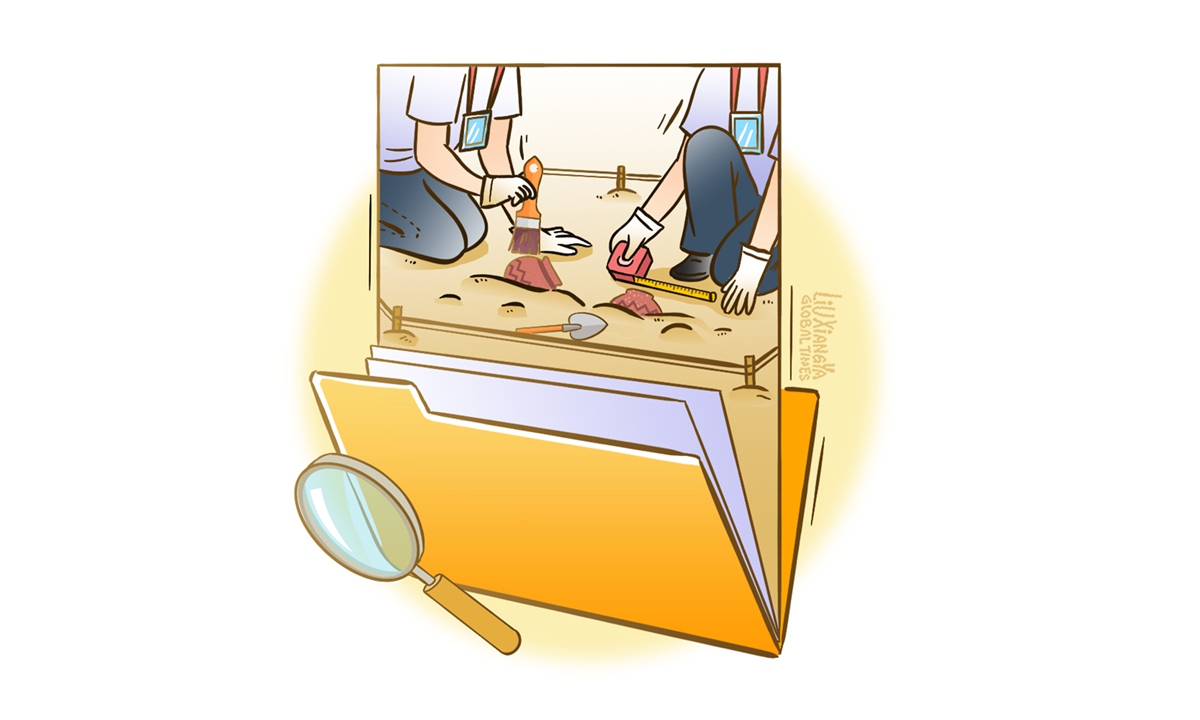
Illustration: Liu Xiangya/GT
China's National Cultural Heritage Administration (NCHA) on Wednesday released a guideline on promoting high-quality development of archaeological research and education, marking a significant step forward in the preservation and promotion of cultural heritage across the whole nation.
The guideline outlines five key points: adhering to the correct direction of archaeological research and education, opening up various archaeological resources, strengthening talent cultivation and curriculum development, ensuring the safety and order of research and education activities, and enhancing support, incentives, and standardized guidance.
One of the most notable proposals is the call for the opening of various archaeological research and education resources. Provincial cultural heritage administrative departments are encouraged to establish and publish lists of venues available for archaeological research and education. This includes archaeological site parks, site museums, archaeological research institutes, archaeological specimen storage rooms, and archaeological sites, all of which are expected to conduct archaeological research and education activities in a standardized and orderly manner.
Officials from the NCHA have indicated that through archaeological research and education activities, participants can engage in multiple experiences within archaeological institutions and venues. This approach is an effective means of understanding and comprehending the history of ancient China and Chinese civilization, which is beneficial for the inheritance and promotion of China's fine traditional culture and for nurturing the public's scientific literacy and humanistic spirit.
From archaeological site parks, museums, archaeological workstations to excavation sites, in recent years, various regions in China have introduced distinctive research and education products and services. The effective transformation of archaeological findings has provided the public with deep experiences and practical education opportunities.
NCHA has highlighted several exemplary cases, including one project launched by the Chongqing Cultural Relics and Archaeology Research Institute.
Students participating in the program are tasked with completing three missions. They need to act as treasure hunters to retrieve important clues from a "band of thieves," decoding Morse code under the guidance of a mentor to gather information on cultural relics. Then the students need to learn about the protection of cultural relics, experiencing the restoration and conservation of relics through methods such as piecing and adhering fragments together. In the end, under the guidance of mentors, the youth will also learn about precious cultural relics unearthed in the Bashu region dating to different periods such as the Western Zhou Dynasty (1046BC-771BC) and Tang Dynasty (618-907). They will gain insight into the restoration and display of ancient tombs, as well as the evolution of tomb burials and related knowledge from ancient times to the present.
Fan Lili from the institute told the Global Times on Thursday that the Chongqing Archaeological Research and Education Base, relying on the archaeological field resources of the Chongqing Cultural Relics and Archaeology Research Institute, has developed a series of research and education programs suitable for all age groups.
Since it began official operations on September 29, 2022, the base has carried out more than 200 public archaeology, research and education activities, hosting over 80,000 participants. The immersive theater has held more than 500 performances, reaching an audience of nearly 20,000 people, she said.
The Beijing Archaeological Research Institute (BARI) has also been an active participator in the field of archaeological research and education. This summer, it conducted the Liulihe Summer Field School, where four international students from the US engaged in archaeological research and education activities at the Liulihe relic site in Beijing's Fangshan district for over a month. They diligently learned the theories and practical methods of Chinese archaeology.
The Liulihe relic site is considered to be the capital of the Yan kingdom during the Western Zhou Dynasty. The site contains rammed earth city walls, remains and burial areas. A history of more than 3,000 years makes the site the earliest traceable source of urban civilization in Beijing.
Wang Jing, a research fellow from BARI who participated in the project, told the Global Times on Thursday that the four US students are majoring in archaeology, anthropology and museology. They show strong interest in Chinese archaeology and they will be able to make good use of what they learned and to carry on cooperation with Chinese partners.
Wang said carrying on such archaeological research and education activities is also beneficial for introducing Chinese experience in archaeology to other countries and fostering international talents in archaeology. She added that the international project in archaeology will continue to be held in the next few years.
The author is a reporter with the Global Times. life@globaltimes.com.cn




